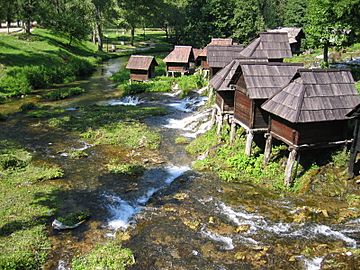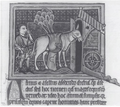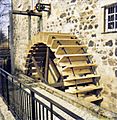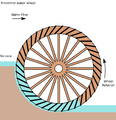Watermill facts for kids
A watermill is like a special machine that uses the power of moving water to do work. Imagine a big wheel or a spinning turbine pushed by a river or stream. This movement then powers other machines to make things like flour from grain, cut lumber from trees, or even shape metal. If a watermill only makes electricity, we usually call it a hydroelectric plant.
Contents
History
Early Watermills
People have used watermills for a very long time! In 31 AD, a Chinese engineer named Du Shi invented a water-powered machine. It used gears and levers to work bellows, which helped make cast iron in a blast furnace. More detailed descriptions of watermills appeared in Chinese writings around the 5th century.
Ancient Greece and Rome
The ancient Greeks and Romans also used watermill technology. Around the 1st century BC, a Greek writer named Antipater of Thessalonica was the first to mention the waterwheel. He praised it because it made grinding grain much easier and saved people a lot of hard work.
The Romans used different kinds of waterwheels, some fixed and some floating on water. They also brought water power to other countries in the Roman Empire.
- 'Greek Mills' had waterwheels with a vertical shaft. These were older and simpler. They worked best with fast-moving water and small millstones.
- 'Roman Mills' had a horizontal shaft. These were more complex because they needed gears to transfer power from the horizontal shaft to a vertical one.
A great example of a Roman watermill is the site at Barbegal in southern France. In the early 4th century, 16 large waterwheels there powered a huge flour mill.
During the Middle Ages, a group called the Cistercian Order built many large watermill complexes across Western Europe. Watermills became very important for many different industries.
Medieval Europe's Mills
In medieval Europe, watermills were used for many new things. For example, the first fulling mills (for finishing cloth) appeared in France around 1080. Forge mills (for shaping metal) were used in England and France by about 1200. Sawmills, which cut timber, started appearing around 1300 in France. Watermills were truly a big step forward in technology!
How a Watermill Works
Here's how a watermill usually works:
- First, water is taken from a river, a pond, or a special channel. This channel might be called a flume, head race, or mill race.
- The moving water then pushes the blades of a water wheel or a turbine.
- This makes an axle spin, which then powers the mill's other machines.
- After the water leaves the wheel, it flows away through another channel called a tail race. Sometimes, this tail race can even become the head race for another watermill!
- Special sluice gates control how much water flows to the wheel. These gates also help with maintenance and can prevent floods. Large watermill sites might have many gates controlling complex water channels.
Watermills can have two main designs:
- Some have a horizontal waterwheel on a vertical axle. These are often older designs. The water hits a simple paddle wheel, which spins a "runner stone" directly. The problem with this type was that the speed of the water directly controlled how fast the millstone turned.
- Others have a vertical wheel on a horizontal axle. These are more common and often use gears to control the speed of the millstones.
Types of Watermills
Watermills were used for many different jobs:
- Gristmills: These were the most common type. They ground grain into flour.
- Fulling mills: Used to finish cloth, making it thicker and stronger.
- Blade mills: Used for sharpening new blades.
- Sawmills: Cut timber into planks of lumber.
- Barking mills: Stripped bark from trees for use in tanneries (where leather is made).
- Spoke mills: Turned lumber into spokes for carriage wheels.
- Cotton mills: At the start of the Industrial Revolution, many of these mills, which made cotton fabric, were powered by water wheels.
- Carpet mills: Sometimes used water power to make rugs.
- Textile mills: Used water power for weaving cloth.
- Powder mills: Made black powder or smokeless powder.
- Blast Furnaces, finery forges, slitting mills, and tinplate works: These were all powered by water until the steam engine was invented. They were sometimes called iron mills.
- Smelt mills: Used to melt lead.
- Paper mills: Used water not only for power but also a lot of water in the paper-making process itself.
Related pages
Images for kids
-
Watermill of Braine-le-Château, Belgium (12th century)
-
Model of a Roman water-powered grain-mill described by Vitruvius. The millstone (upper floor) is powered by an undershot waterwheel by the way of a gear mechanism (lower floor)
-
German ship mills on the Rhine, around 1411
-
An Afghan water mill photographed during the Second Anglo-Afghan War (1878-1880). The rectangular water mill has a thatched roof and traditional design with a small horizontal mill-house built of stone or perhaps mud bricks
-
A watermill in Tapolca, Veszprem County, Hungary
-
Mulino Meraviglia in San Vittore Olona, Italy, along Olona river
-
Watermill in Caldas Novas, Brazil
-
A Northern Song era (960–1127) water-powered mill for dehusking grain with a horizontal wheel
-
Roblin's Mill, a watermill, at Black Creek Pioneer Village in Toronto, Ontario, Canada
-
The interior of a functional watermill at Weald and Downland Open Air Museum
-
A breastshot waterwheel at Dalgarven Mill, United Kingdom
See also
 In Spanish: Molino hidráulico para niños
In Spanish: Molino hidráulico para niños


















